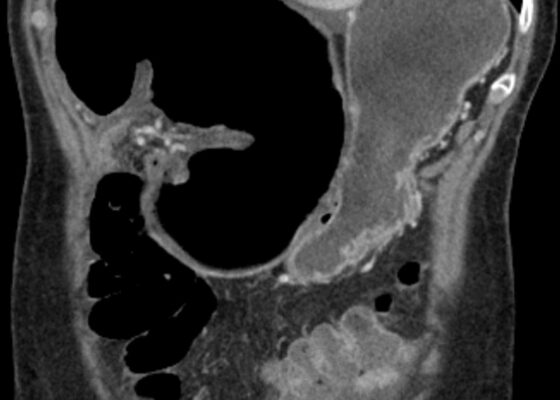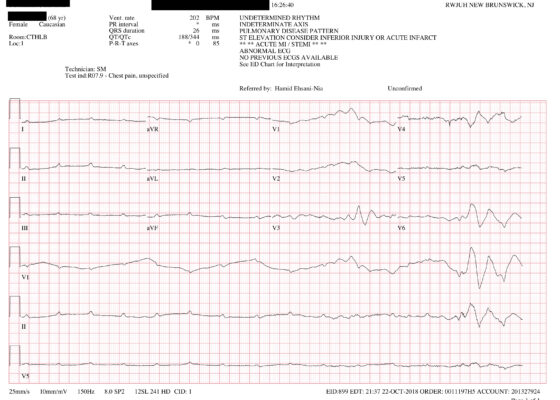Latest Articles
Cecal Volvulus Diagnosed with a Whirl Sign: A Case Report
DOI: https://doi.org/10.21980/J8XM05The CT image demonstrates a “whirl sign” (red arrow) which is indicative of a volvulus. This image occurs when bowel, mesentery and vasculature rotate around a transition point causing an image similar to a hurricane on a weather map. When seen on a CT scan, a whirl sign suggests a high likelihood of either a closed loop bowel obstruction or volvulus in the cecum, sigmoid or midgut. In any of the cases, seeing a whirl sign strongly increases the need for emergent surgical management.
Paroxysmal Ventricular Standstill—A Case Report of all Ps and no QRS in Ventricular Asystole
DOI: https://doi.org/10.21980/J8SS79In route, it was proposed that this patient was suffering from a dysrhythmia due to the transient episodes of syncope with lack of ventricular activity on telemetry. Upon close examination of the rhythm strips as well as the ECG, P waves can be visualized without any accompanying QRS complexes lasting multiple seconds (ED ECG blue arrows). Additionally, the rhythm has an intrinsic rate of 100 beats per minute and has a consistent morphology with no evidence of ventricular activity due to the lack of QRS complexes. As a result, the rhythm likely originates in the atria with no passage of impulses into the ventricles through the atrioventricular (AV) node versus an accelerated ventricular rhythm where QRS complexes would be seen.8 These rhythm strips demonstrate an example of VS. There is preserved native atrial automaticity, with an intact sinoatrial (SA) node, with a complete lack of ventricular electrical activity
Hemoptysis Due to Diffuse Alveolar Hemorrhage
DOI: https://doi.org/10.21980/J8ZP86By the end of this simulation session, learners will be able to: (1) recognize worsening respiratory status of a patient with hemoptysis and intervene appropriately, (2) manage a patient with severe hemoptysis and perform appropriate ventilator management, (3) manage sinus tachycardia with QT prolongation on the ECG caused by cocaine and hypomagnesemia, (4) address various etiologies of hemoptysis, (5) discuss the causes of massive hemoptysis and management options, and (6) review ventilation strategies in an intubated hypoxic patient.
Improving Emergency Department Airway Preparedness in the Era of COVID-19: An Interprofessional, In Situ Simulation
DOI: https://doi.org/10.21980/J8V06MAt the conclusion of the simulation session, learners will be able to: 1) Understand the need to notify team members of a planned COVID intubation including: physician, respiratory therapist, pharmacist, nurse(s), and ED technician. 2) Distinguish between in-room and out-of-room personnel during high-risk aerosolizing procedures. 3) Distinguish between in-room and out-of-room equipment during high-risk aerosolizing procedures to minimize contamination. 4) Appropriately select oxygenation therapies and avoid high-risk aerosolizing procedures. 5) Manage high risk scenarios such as hypotension or failed intubation and be prepared to give push-dose vasoactive medications or place a rescue device such as an I-gel®.
Eclampsia
DOI: https://doi.org/10.21980/J8M93DAt the end of this oral boards session, examinees will: 1) Demonstrate ability to obtain a complete medical history including a detailed obstetric history. 2) Demonstrate the ability to perform a detailed physical examination in a postpartum female patient who presents with a seizure. 3) Investigate the broad differential diagnoses which include electrolyte imbalances, brain tumor, meningitis or encephalitis, hemolysis, elevated liver enzymes, low platelets (HELLP) syndrome and eclampsia. 4) List the appropriate laboratory and imaging studies to differentiate eclampsia from other diagnoses (complete blood count, comprehensive metabolic panel, magnesium level, pregnancy testing, urinalysis, and computed tomography [CT] scan of the head). 5) Identify a postpartum eclampsia patient and manage appropriately (administer IV magnesium therapy, administer IV antihypertensive therapy, emergent consultation with an obstetrician). 6) Provide appropriate disposition to the intensive care unit after consulting with an obstetrician.
Low Fidelity Trainer for Fiberoptic Scope Use in the Emergency Department
DOI: https://doi.org/10.21980/J8764BBy the end of this training session, learners will be able to 1) list indications, contraindication, and complications in performing fiberoptic intubations, 2) know how to use and maneuver a fiberoptic scope, and 3) be able to successfully intubate the trainer model.


